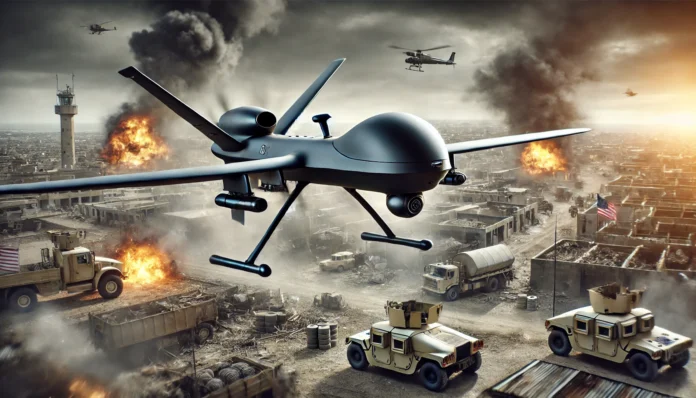Autonomous drones, powered by artificial intelligence (AI), are rapidly becoming a cornerstone of modern military strategies. In conflict zones such as Ukraine, these AI-driven warfare systems have demonstrated unprecedented capabilities, from intelligence gathering and targeted strikes to surveillance and drone-on-drone combat. As AI technology continues to evolve, the use of autonomous drones in warfare is reshaping the battlefield, reducing human involvement in dangerous missions and increasing the precision of military operations.
The Evolution of AI-Driven Warfare
AI has fundamentally changed the way military forces approach the use of drones in conflict zones. Traditionally, drones required human operators to control their movements and execute missions. However, the development of autonomous systems powered by AI now enables drones to fly missions independently, make real-time decisions, and even coordinate with other drones to complete complex tasks.
Key Capabilities of AI-Driven Drones
AI-driven drones are capable of real-time data processing, object recognition, and autonomous navigation, making them highly effective in dynamic combat environments. They can operate with minimal human intervention, allowing military forces to deploy them for high-risk missions without endangering personnel.
- Autonomous Navigation: AI-powered drones use advanced algorithms to navigate independently, identifying obstacles, adjusting flight paths, and avoiding enemy defenses.
- Target Identification: AI systems enable drones to recognize and classify targets on the battlefield, allowing for precision strikes with minimal risk of collateral damage.
- Swarm Coordination: AI-driven drones can operate in coordinated swarms, working together to achieve mission objectives, whether it be overwhelming enemy defenses or gathering surveillance data.
The Role of AI-Driven Drones in the Ukraine-Russia Conflict
In the ongoing Ukraine-Russia conflict, both sides have increasingly relied on autonomous drones for a range of military operations. From loitering munitions to reconnaissance missions, AI-driven drones have provided a significant strategic advantage by reducing the need for human pilots and enhancing the effectiveness of strikes.
Loitering Munitions: Precision Strikes with AI
Loitering munitions, also known as kamikaze drones, have been widely deployed in the Ukraine conflict. These drones are equipped with AI systems that allow them to loiter over a target area, identify enemy assets, and execute a self-destructive attack at the optimal moment.
- Shahed-136: Used extensively by Russian forces, this AI-powered loitering munition has been deployed for long-range strikes on Ukrainian infrastructure. Its ability to navigate autonomously and evade air defenses makes it highly effective.
- Switchblade 600: Deployed by Ukrainian forces, the Switchblade drone can autonomously identify and target Russian tanks and artillery positions, delivering precision-guided strikes on high-value targets.

AI-Enhanced Surveillance Drones
Surveillance drones equipped with AI systems have played a critical role in gathering real-time intelligence in Ukraine. These drones are capable of analyzing large volumes of data in real time, providing military commanders with actionable insights that can be used to direct ground operations or airstrikes.
- Orlan-10: This Russian surveillance drone has been enhanced with AI capabilities, allowing it to process imagery and thermal data autonomously, identifying Ukrainian military positions and directing artillery fire.
- Aerorozvidka R18: A Ukrainian drone that uses AI-powered thermal cameras to detect Russian troop movements, providing valuable intelligence for Ukrainian artillery units.
AI-Driven Drones in Combat: Autonomous Weapon Systems
The integration of AI into combat drones has transformed how military forces engage enemy targets. Autonomous weapon systems allow drones to operate independently in hostile environments, conducting target acquisition, tracking, and engagement without direct human control.
Drone Swarms in AI-Driven Combat
One of the most significant advancements in AI-driven warfare is the use of drone swarms. These swarms are composed of multiple UAVs that can coordinate their movements and attack in unison, overwhelming enemy defenses through sheer numbers and collective intelligence.
- AI-Powered Swarm Tactics: Both Ukrainian and Russian forces have tested swarm tactics in the conflict, deploying groups of drones that communicate in real time and adjust their strategies based on battlefield conditions.
- Swarm Combat Applications: Swarms have been used for reconnaissance, target saturation, and electronic AI-driven warfare, disrupting enemy air defenses and increasing the likelihood of mission success.
Targeting Enemy Assets with AI
AI-driven drones are equipped with advanced sensors and machine learning algorithms that allow them to autonomously identify and engage enemy assets. These drones can process data from multiple sensors, including optical, thermal, and infrared, to detect and track targets in real time.
- Lancet-3: This Russian kamikaze drone uses AI to loiter over the battlefield and identify Ukrainian military assets, including radar systems and artillery, before launching a precision strike.
- Bayraktar TB2: While not fully autonomous, the Bayraktar TB2 drone used by Ukraine has incorporated AI-enhanced targeting systems, improving its accuracy in targeting Russian tanks and fortifications.
AI and Autonomous Decision-Making in Warfare
One of the most controversial aspects of AI-driven drones is their ability to make autonomous decisions without human intervention. These decisions include identifying targets, engaging the enemy, and even adjusting flight paths to avoid defenses or obstacles. The use of autonomous decision-making in AI-driven warfare raises important ethical and legal questions about the role of AI in military operations.
Advantages of Autonomous Decision-Making
AI-driven drones can process data and make decisions far more quickly than human operators. This speed is especially critical in fast-paced combat environments, where every second counts.
- Reduced Response Time: AI can react to changes on the battlefield in real time, identifying and engaging threats instantly.
- Mission Flexibility: Autonomous drones can adjust their strategies mid-mission, rerouting to new targets or avoiding enemy defenses without human input.
Ethical Concerns of AI-Driven Warfare
The use of AI in autonomous weapons systems has sparked debates over the ethics of allowing machines to make life-or-death decisions. Critics argue that AI lacks the moral judgment necessary for responsible decision-making in combat, while proponents believe that AI can reduce human casualties by improving the accuracy of strikes and minimizing collateral damage.
- Accountability: Who is responsible when an AI-driven drone makes an error or engages an unintended target? This question is central to the debate over autonomous AI-driven warfare.
- Moral Implications: The use of autonomous drones challenges the traditional concept of human accountability in warfare, raising concerns about the potential for unintended escalations in conflicts.
The Future of AI-Driven Drone Warfare
The future of drone warfare is increasingly dependent on advances in AI technology. As AI systems become more sophisticated, drones will be able to carry out more complex missions, including multi-domain operations that integrate land, sea, and air forces.
Advances in AI-Driven Autonomy
The next generation of AI-driven drones will likely feature enhanced autonomy, allowing them to operate for extended periods without human input. These drones will be capable of adapting to evolving battlefield conditions, using machine learning algorithms to improve their performance over time.
- Self-Learning Drones: Future AI systems may enable drones to learn from each mission, improving their capabilities and becoming more effective at avoiding defenses and identifying targets.
- AI-Enabled Swarm Drones: The use of AI-powered swarm drones will continue to grow, allowing military forces to deploy large numbers of UAVs in coordinated attacks on enemy positions.
Conclusion
AI-driven drones are transforming modern AI-driven warfare by providing military forces with unprecedented capabilities in reconnaissance, targeted strikes, and autonomous decision-making. As AI technology continues to evolve, the role of autonomous drones in conflict zones will only grow, reshaping the future of AI-driven warfare. However, with this technological progress comes a host of ethical and legal challenges, as nations must decide how to regulate the use of AI in military operations and ensure that autonomous weapons systems are used responsibly.


